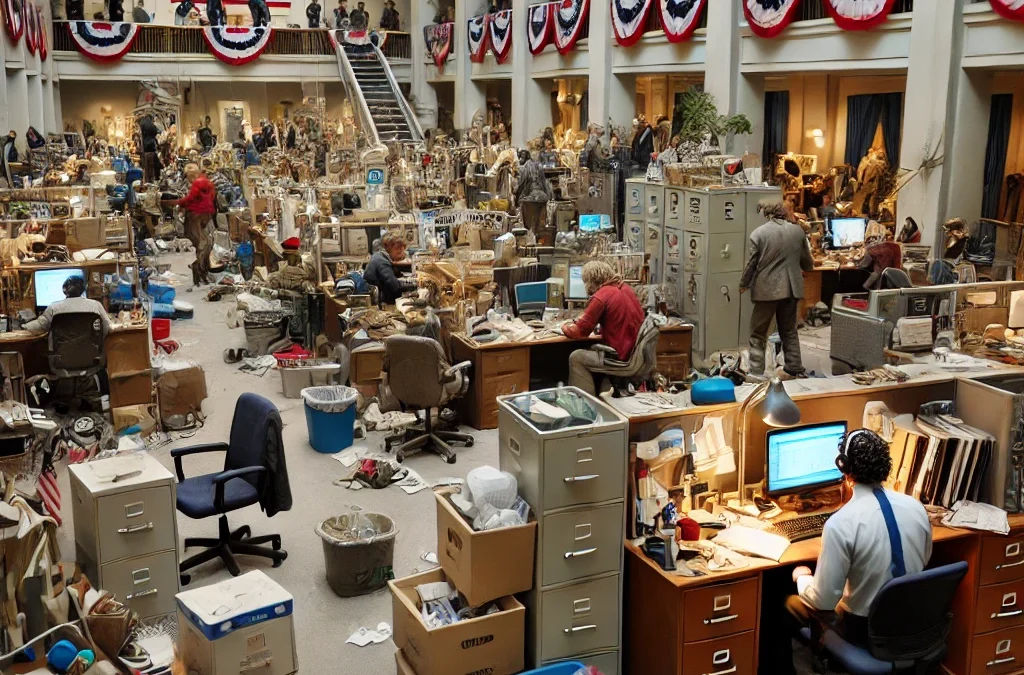In January 2025, President Donald Trump issued an executive order mandating the termination of remote work arrangements for federal employees, requiring a full-time return to in-person work. This directive has sparked extensive discussions regarding its impact on federal operations, employee morale, and government efficiency.
Details of the Executive Order
The executive order mandated that heads of all executive branch departments and agencies “take all necessary steps to terminate remote work arrangements and require employees to return to work in-person at their respective duty stations on a full-time basis.” Agency heads were granted the discretion to make exemptions as deemed necessary.
Rationale Behind the Order
The administration asserted that in-person collaboration strengthens productivity, mission delivery, and public service. Acting Director of the Office of Personnel Management, Charles Ezell, emphasized the commitment to ensuring a smooth transition by addressing workplace concerns, including facility conditions and resource availability.
Immediate Impact on Federal Employees
The directive significantly altered the work routines of approximately 1.1 million telework-eligible federal employees. Many expressed concerns about the abrupt shift, citing challenges related to commuting, work-life balance, and childcare arrangements. Union representatives highlighted the potential negative impact on employee morale and retention.
Operational Challenges Faced by Agencies
Agencies encountered logistical hurdles in accommodating the sudden influx of employees returning to the office. Issues such as inadequate office space, insufficient resources, and outdated infrastructure were reported. For instance, some offices faced shortages of basic supplies and functional workspaces, leading to decreased productivity and employee dissatisfaction.
Financial Implications
The transition back to in-person work incurred significant costs. Reports indicated that since October 2020, the federal government spent approximately $4.6 billion on new furniture, despite many offices remaining underutilized due to remote work arrangements. This expenditure raised questions about fiscal responsibility and resource allocation.
Legal and Union Responses
Federal employee unions challenged the executive order, arguing that it undermined negotiated telework agreements and employee rights. Legal battles ensued, with some courts temporarily blocking aspects of the order. However, the Supreme Court ultimately upheld the administration’s directive, leading to the termination of remote work for many federal employees.
Comparative Analysis with Private Sector
In contrast to the federal mandate, many private sector companies continued to embrace flexible work arrangements, recognizing benefits such as increased employee satisfaction and reduced operational costs. This divergence highlighted differing approaches to workforce management between the public and private sectors.
Productivity and Performance Metrics
Studies evaluating the impact of the return-to-office mandate on productivity yielded mixed results. While some reports suggested a decline in efficiency due to logistical challenges and employee dissatisfaction, others indicated improvements in collaboration and mission delivery. The overall effect appeared to vary across agencies and departments.
Employee Well-being and Work-life Balance
The abrupt transition back to in-person work raised concerns about employee well-being. Issues such as long commutes, disrupted family routines, and increased stress levels were reported. Agencies were urged to implement support systems to address these challenges and promote a healthy work environment.
Public Perception and Media Coverage
The executive order received extensive media coverage and elicited diverse public opinions. While some viewed it as a necessary step toward restoring government efficiency, others criticized it as a regressive move that disregarded modern work trends and employee preferences.
Future of Remote Work in Federal Agencies
The mandate sparked discussions about the potential for hybrid work models in the federal government. Advocates argued for flexible arrangements that balance in-person collaboration with the benefits of remote work, suggesting that such models could enhance recruitment and retention of top talent.
Technological and Infrastructure Considerations
When you uproot thousands of remote federal employees and shove them back into aging government buildings, you quickly realize just how unprepared those spaces are. From outdated tech systems to leaky ceilings and fragile internet connections, many agencies were simply not ready for this massive return. And while you’d think the federal government—one of the biggest employers in the country—would have a solid infrastructure plan, the reality has been chaotic.
Some employees came back to find their workstations dismantled or nonfunctional. Broken monitors, chairs that date back to the Clinton era, and even offices that had been repurposed during the pandemic were suddenly thrust back into service. In several high-profile buildings like those housing the IRS and FDA, workers found themselves squeezed into makeshift workspaces, often forced to conduct sensitive conversations from their cars due to lack of private meeting areas.
Connectivity has also been a recurring nightmare. Offices that once supported 30% occupancy are now buckling under full loads, with spotty Wi-Fi, crashed video calls, and sluggish networks that can’t handle today’s collaborative software tools. This has led many to question whether productivity is truly being enhanced or if workers are simply spending more time troubleshooting than working.
Moreover, cybersecurity—once tightly managed in remote setups—has now become harder to enforce as outdated on-premises systems lag behind modern cloud-based protections. Rather than boosting efficiency, the tech setup has become another bottleneck in an already controversial mandate.
Case Studies of Specific Agencies
Let’s zoom in on a few agencies to get a clearer picture.
At the Department of Defense, returning employees were met with stark conditions. Offices in aging buildings had minimal maintenance during the remote years. Reports of rats, overflowing trash cans, and even Legionella bacteria in water systems made headlines. Morale? Rock bottom. Staffers who once felt productive and engaged working from home now dread the long commutes and frustrating office conditions.
The Internal Revenue Service told a similar tale. Their downtown Atlanta office had so many broken elevators and infrastructure failures that staff often waited 20+ minutes just to reach their floors. Desks were mismatched, chairs were missing, and many employees were essentially squatting in any available cubicle they could find—sometimes setting up in storage closets to get work done in peace.
Then there’s the Food and Drug Administration. Known for adopting telework long before the pandemic, their Maryland campus was absolutely overrun. Employees showed up at 6:30 a.m. just to snag a parking spot. Internet connections buckled under the new strain, and basic office supplies were so scarce that workers had to bring their own keyboards and even cleaning supplies. For an agency tasked with safeguarding public health, the irony was glaring.
These aren’t one-off problems—they represent a larger trend of agencies scrambling to meet an executive order without having the tools, space, or planning to execute it well.
The “Trump remote work executive order” isn’t just a bureaucratic directive—it’s a sweeping change that’s disrupted the lives of millions of federal employees. What was pitched as a move toward efficiency has, in many ways, highlighted the inefficiencies of a system still stuck in the past. Crumbling buildings, overwhelmed tech infrastructure, and demoralized staff paint a picture that’s far from productive or streamlined.
It’s clear that while in-person work has its place, a more nuanced approach—one that blends flexibility, modern infrastructure, and employee well-being—may offer the government the best path forward. Ignoring these realities not only risks lower morale but may also push away the very talent needed to make federal agencies effective in the modern age.

